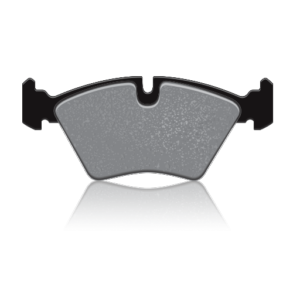Brake pad for disc brake
SELECT YOUR VEHICLE TO FIND THE RIGHT PARTS!

All you need to know about brake linings
The brake linings are the key components in the balanced brake system; therefore, it is important to comply with all the basic rules related to the friction characteristics, including factory made or aftermarket products.
The brake linings are parts of the brake system. Their quality has an important role in ensuring the proper braking and stopping the vehicle within the braking distance. When the brake pedal is depressed, then the brake lining is pressed to the brake disk, as a result of which the vehicle is decelerated and then stopped.
Types of brake linings
Always use brake lining types and grades corresponding to the instructions of the manufacturer.
Corresponding to the material of the wearing surface the brake linings may have organic, sintered and ceramic friction surfaces. Their compatibility is decided by the instructions of the manufacturers and the actual type of the vehicle. It is unwarranted to deviate from the instructions by the manufacturer in case of use on public road, and it would be dangerous too.
Tips for handling the brake linings
- The operating life of brake lining depends on the driving style and on the load on the vehicle.
- The life cycle of the brake linings is shortened if frequent and intensive braking is applied, because the break lining wear faster.
- The average life span is 20,000-40,000 km.
- Immediate replacement is recommended as soon as the wearing surface becomes 2-3 mm thick.
Sign of faulty brake linings:
- Recent vehicles are provided with wear indicators in their brake systems, which reliably indicate when the wearing surface of the brake lining reaches the minimum value. This indicator could be acoustic or electronic.
- Uneven wearing of brake lining.
- Laud, screeching or whistling sound comes from the direction of the wheels.
Reasons of early fault of brake linings.
- Worn brake disks.
- Dust, dirt of alien material between the brake disk and the brake lining.
- Aggressive, sports style driving.
- Fault in the brake cylinder.
For safety reason it is desirable to perform works on the brake system in professional workshops!!
FAQ
Look around in the help center.
How long are the brake linings remain sufficient? How many of them are in the set?
- The parts are useable up to 30-50 thousand km on the average in case of manual gearbox, or up to 25-30 thousand km when automatic gearbox is used in the vehicle. The operating life of the parts depends on a number of factors:
- Individual driving stale.
- Type of vehicle. Heavy vehicles often need replacement of parts.
- Extent of brake lining wear. The uneven surface of damaged parts deteriorates the condition of linings.
- Seizing the pistons in the brake saddle, which causes the uneven wear of parts.
- Composition of friction lining.
- One set generally contains 4 parts – i.e., 2 parts for each axle. Some sets contain 8 parts each. It depends on the kind of vehicle in question.
What are the signs of faulty brake linings?
- The wearing indicator shows that the parts need replacement
- Screeching sound during braking
- The brake pedal needs stronger push to reach the usual brake action.
- Decreasing brake action
What causes the fault of brake lining?
- The part is not fixed properly
- Worn brake disks
- Dust, dirty or alien material on the surface
- Inadequate installation
- Aggressive driving style.
- Fault in the brake cylinders
How should I change brake lining in my vehicle
- Repair or restoration of the brake linings is not recommended. It has to be replaced if it does not operate properly.
- The replacement of brake linings will extend the life span of brake disks and the entire brake system. You may be able to replace the brake lining yourself, only a few tools are necessary for that.
Make the following operations:
- Engage the parking brake and lift the vehicle.
- Remove the wheels
- Drive out the fastening pins and the guide bolts
- Use a plier or a screw driver to pull out the cylinders from the cylinder of the brake saddle, and remove the used brake lining
- Put oil on the guide bolts, and perform the above operations in reversed order.
